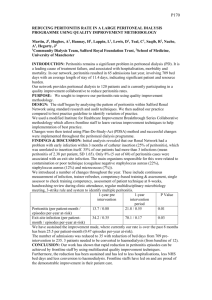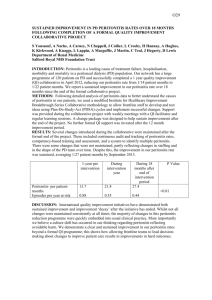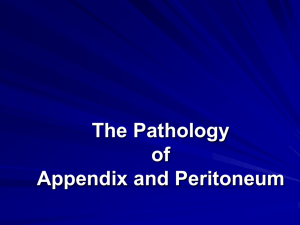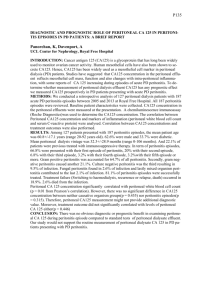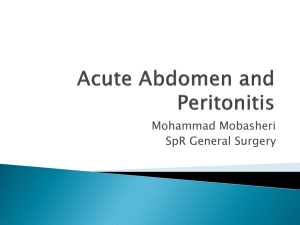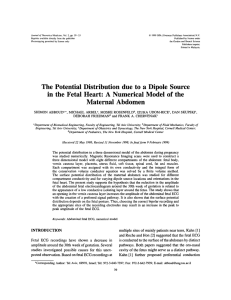Vernix - obgynkw
advertisement
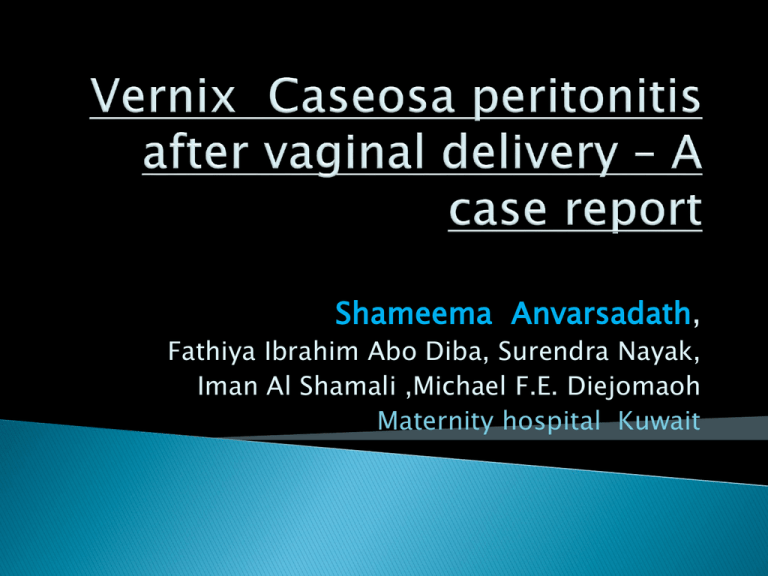
Shameema Anvarsadath, Fathiya Ibrahim Abo Diba, Surendra Nayak, Iman Al Shamali ,Michael F.E. Diejomaoh Maternity hospital Kuwait Mrs. A, 28 years, G3 P2+0+0+2 41 weeks in active labour Obs history ◦ 1 st :LSCS for fetal distress ◦ 2nd Term vaginal delivery of 3.5 kg baby 1 year back Current pregnancy uneventful At admission to labour room Pulse rate 110 /mt, BP : 115/80 Temp : 37.20c Vaginal examination : Cervix 8 cm dilated . Vertex at -2 Artificial rupture of membranes - clear liquor. Investigations at admission: Hb: 12.9gm/dl ,WBC:10.6, P75%,L16%. Platelet:158 After 1 hour :Fully dilated with vx at +1 Fetal heart decelerations Vacuum extraction-male baby 4.410 Kg Apgar 7&8 After 3 hours Abdominal pain and distension! O/E : No pallor, Pulse 118/mt. BP: 105/70, Temp: 37.90c SPO2:100% on room air,Respiratory rate:20-/mt. Abdomen was distended with generalized diffuse tenderness. Investigations: Hb: 11.6gm/dl, WBC: 17.4, P : 93%,L: 3%, Platelet : 149 Ultrasound abdomen : Significant amount of free fluid in hepatorenal and lienorenal angles and in the pelvis . Normal puerperal uterus and ovaries Small hemangioma in the liver. CT abdomen was planned Abdominal pain increased in severity over next 2 hours. Diff.diagnosis Ruptured uterus other surgical emergencies Decision for laparotomy LAPAROTOMY –MIDLINE INCISION ◦ 500 ml turbid fluid in the peritoneal cavity. ◦ Patches of cheesy material on the serosal surface of all the viscera. Uterus intact . Normal appendix, liver, spleen, intestines Few enlarged mesenteric nodes Biopsy from the node and cheesy material Omental biopsy Fluid for culture Post op: IV ceftriaxone & metronidazole. Recovery was uneventful Squamous epithelium surrounded by acute inflammatory response. Lanugo hair surrounded by acute inflammatory response. Histopathology: ◦ Peritoneal content and omentum : VERNIX CASEOSA PERITONITIS ◦ Mesenteric lymph node Nonspecific reactive changes A very unusual complication Due to inflammatory response to amniotic fluid spilled into the maternal peritoneal cavity presenting as acute abdomen Only 24 cases have been reported All are after uneventful caesarean section 3 cases had onset from the antenatal period. Ours is the first case of VCP reported following vaginal delivery. Vernix caseosa: Cheesy white cutaneous material covering the skin of the newborn Sebaceous glandular secretions+ lanugo hairs +desquamated squamous cells. Numerous squamous cells are present in the amniotic fluid Incomplete peritoneal lavage of spilled amniotic fluid after Caesarean Antenatal or intra partum leakage of amniotic fluid ◦ ?? utero tubal reflux ◦ ?? unrecognized uterine perforation Exact mechanism is unknown Mechanical irritation by keratinised squamous cells (as in meconium peritonitis/ruptured keratinous cysts) ? Hypersensitivity reaction ( in multipara or from an antenatal primary event) Concentration of vernix caseosa in the amniotic fluid may have pathogenetic significance. Acute abdomen ◦ Generalized severe abdominal pain, ◦ Pyrexia, ◦ Peritonism Present in few days to weeks after an inciting event. Elevated white cell count Inconclusive or normal imaging. Other causes of peritonism should be excluded Essential feature: White and yellow cheesy plaques within the peritoneal cavity and on serosal surfaces in the absence of inflamed organs Histopathology confirms the diagnosis Desquamated anucleate squamous cells sorrounded by acute,chronic(granulomatous) or mixed inflammatory infiltrate depending on the duration of onset Most are self limiting. Resolves with conservative management post op antibiotic therapy adjuvant steroid therapy may be used (mahmoudetal 1997) Significant morbidities following the initial diagnosis of VCP including bowel obstruction also has been reported (stuart et al 2009) Many cases had significant additional procedures including cholecystectomy , appendectomy ,partial colectomy , total hysterectomy and bilateral salpingectomy. (stuartetal 2009, boothby et al1985,cummingsetal 2001, Hertzetal1985,Mahmoudetal 1997) Subsequent finding of normal histology in the excised organs. Role of preoperative CT and fine needle aspiration cytology /guided biopsy?---( james etal2011) not practical Diagnostic laparoscopy with intraoperative pathological examination is suggested (Bailey etal2012) Vernix Caseosa peritonitis is an infrequent cause of puerperal peritonitis Can occur even after vaginal delivery as the inciting event can be antenatal or intra partum Postpartum patients with acute abdomen—keep in mind diff: diagnosis of VCP . Characteristic intra op findings and intra op involvement of pathologist help to resort to a more conservative approach and prevent unnecessary invasive procedures. References:1. 2. Jonathan G Bailey,Dennis Klassen:Laparoscopic experience with vernix caseosa peritonitis.surg endosc DOI 1007/s00464-012-2320-6 James Richard Myers, Charitha Fernando : Radiology of vernix caseosa peritonitis : case report and discussion. Journal of Medical Imaging and Radiation Oncology 2011, 55(3) : 301 – 303. 3. Erika Wisanto, Mathieu D'Hondt : A cheesy diagnosis Lancet 2010 376 (9740) : 564 4. Olivia A Stuart, Alastair R Morris: Vernix Caseosa Peritonitis – no longer rare or innocent : a case series. Journal of Medical Case Reports 2009, 3:60 5. Selo- Ojeme D; Vernix caseosa peritonitis J Obstet Gynaecol 2007, 27(7): 660-663 6. Cummings B, Scarth HM, Tran HT, Walley VM: Caseosa peritonitis presenting post partum as acute cholecystitis. Can J Surg 2001, 44(4): 298-300 7. Tawfik O, Prather J, Bhatia P, Woodroof J, Gunter J, Webb P: Caseosa peritonitis as a rare complication of cesarean section . A case report. J Reprod Med 1998, 43 (6): 547- 550 8. Davis JR, Miller HS, Feng JD: Caseosa peritonitis : Report of two cases with antenatal onset. Am J Clin Pathol 1998, 109(3): 320-323 9. Mahmoud A, Silapaswan S, Lin K, Penney D: Vernix caseosa : An unusual cause of post cesarean section peritonitis. Am Surg 1997, 63 (5): 382 – 385 10. George E, Leyser S, Zimmer HL, Simonowitz DA, Agress RL, Nordin DD: Vernix caseosa peritonitis. An infrequent complication of cesarean section with distinctive histopathologic features. Am J Clin Pathol 1995, 1.3 (6 ) : 681-684 11. Boothby R, Lammert N, Benrubi GI, Weiss B: Vernix caseosa granuloma : A rare complication of cesarean section.
